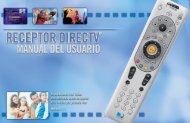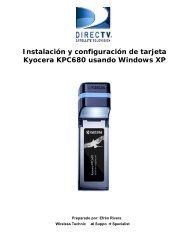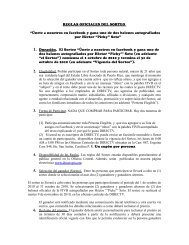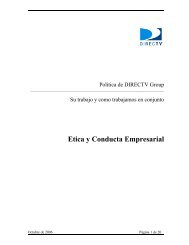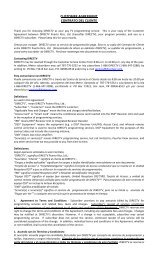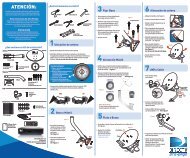Create successful ePaper yourself
Turn your PDF publications into a flip-book with our unique Google optimized e-Paper software.
WaRnInG: To reduce the risk <strong>of</strong> fire or<br />
electric shock, do not expose this product<br />
to rain or moisture. The apparatus shall not<br />
be exposed to dripping or splashing and no<br />
objects filled with liquids, such as vases,<br />
shall be placed on the apparatus.<br />
CaUTIOn<br />
RISK OF ELECTRIC<br />
SHOCK DO nOT OPEn!<br />
CaUTIOn: To reduce the risk <strong>of</strong> electric<br />
shock, do not remove cover (or back).<br />
No user-serviceable parts inside.<br />
Refer servicing to qualified service<br />
personnel.<br />
IMPORTanT: Be sure not to place your<br />
DIRECTV ® Receiver near anything WET or<br />
HOT!<br />
If this product is used at 240VAC, a sui<strong>table</strong><br />
attachment plug should be used.<br />
CaUTIOn: Avoid moisture to reduce the<br />
risk <strong>of</strong> fire or electric shock. The DIRECTV ®<br />
Receiver should not be used near water (for<br />
example, kitchen sink, bathtub, pool, damp<br />
basement). Also, never spill liquid on the<br />
receiver, and do not place vases or other<br />
vessels containing liquid on top <strong>of</strong> it.<br />
TIP: We highly recommend plugging the<br />
DIRECTV Plus ® DVR into a surge protector<br />
to prevent damage from fluctuations in<br />
your power supply.<br />
Safety & Care<br />
• Ensure proper ventilation — the vent slots on the DIRECTV ® Receiver must be left uncovered to allow proper airflow to the unit.<br />
Blocking the airflow to the unit could impair performance or damage your receiver and other components.<br />
• Do not stack electronic components or other objects on top <strong>of</strong> the DIRECTV ® Receiver. Also, do not stack the receiver on top <strong>of</strong> a<br />
“hot component” such as an audio power amplifier.<br />
• Protect your components from power surges by connecting all the components before plugging any power cords into the wall<br />
outlet. Use <strong>of</strong> a surge protector is also recommended.<br />
• Don’t overload power outlets or extension cords, which can result in the risk <strong>of</strong> fire or shock. It’s also important to use only the<br />
type <strong>of</strong> power source indicated on the marking label or in this manual.<br />
• Avoid audio hum or interference by inserting all cable plugs firmly into their jacks. Also, place Audio/Video (A/V) cables to the<br />
sides <strong>of</strong> the TV back panel rather than down the middle once connected. Try not to coil any twin-lead cables and keep them away<br />
from A/V cables as much as possible.<br />
• Never insert objects <strong>of</strong> any kind into any openings in the DIRECTV ® Receiver (other than the DIRECTV ® Access Card as detailed in<br />
this manual).<br />
• Place it on a flat, hard surface — do not operate the DIRECTV ® Receiver on a carpet or other padded surface.<br />
• Always unplug your DIRECTV ® Receiver before moving it.<br />
• Always unplug the DIRECTV ® Receiver, TV and other equipment before you connect or disconnect any cables.<br />
• The only way to disconnect the DIRECTV ® Receiver from the power supply is to remove the power cord. The DIRECTV ® Receiver<br />
unit must therefore be installed next to the power point which must be easily accessible.<br />
• CaUTIOn: Electric Shock — never attempt to disassemble the DIRECTV ® Receiver yourself; always take it to a qualified<br />
service person when repair is required. Opening or removing covers may expose dangerous voltage or other risks, and incorrect<br />
reassembly can cause shock when receiver is subsequently used. Attempted self-repair may also void your warranty. Changes or<br />
modifications not expressly approved by the party responsible for compliance (by the warranty or by the manufacturer) could void<br />
the user’s authority to operate the equipment.<br />
• Do not drop your DIRECTV ® Receiver and always move it with care.<br />
• Have your DIRECTV ® Receiver pr<strong>of</strong>essionally serviced (do not attempt to service it yourself).<br />
• Any changes or modifications in construction <strong>of</strong> this device which are not expressly approved by the party responsible for<br />
compliance could void the user’s authority to operate the equipment.<br />
• If you move your DIRECTV ® Receiver between locations at different temperatures, allow it to reach room temperature before you<br />
apply power to it.<br />
• Do not pick up or otherwise move your DIRECTV ® Receiver while it is connected to the AC power supply. If you want to move your<br />
set-top box, first disconnect it, then wait at least 30 seconds before continuing<br />
• To reduce the risk <strong>of</strong> fire, use only No. 26 AWG or better telecommunications line cord.<br />
For your information: The identification sticker can be located underneath or on the back <strong>of</strong> your receiver.<br />
The telecommunication network voltage used is the category number 3.<br />
note to Satellite Dish Installer<br />
This reminder is provided to call your attention to articles 810 and 820 <strong>of</strong> the 2005 National Electrical Code. Refer to article 810, in<br />
particular 810-1 and 810-15, for required grounding <strong>of</strong> the metal structure <strong>of</strong> the dish antenna. Refer also to the 810-2 which, by<br />
reference to article 820, requires that the satellite dish coaxial cable shield be connected to the grounding system <strong>of</strong> the building as<br />
close to the point <strong>of</strong> cable entry as practical.<br />
9



